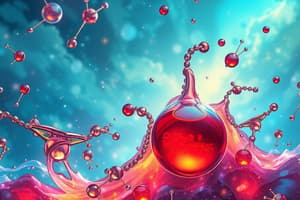Podcast
Questions and Answers
What type of solution forms when nonpolar covalent compounds dissolve in nonpolar solvents?
What type of solution forms when nonpolar covalent compounds dissolve in nonpolar solvents?
- Basic solutions
- Aqueous solutions
- Covalent solutions (correct)
- Ionic solutions
Which type of solution is formed when ionic compounds dissolve in polar solvents like water?
Which type of solution is formed when ionic compounds dissolve in polar solvents like water?
- Aqueous solutions
- Basic solutions
- Ionic solutions (correct)
- Covalent solutions
What kind of solution can be expressed as mass percent (w/w%), molarity (M), molality (mol/kg), or volume percent (v/v%)?
What kind of solution can be expressed as mass percent (w/w%), molarity (M), molality (mol/kg), or volume percent (v/v%)?
- Ionic solutions
- Aqueous solutions (correct)
- Concentrated solutions
- Covalent solutions
In which type of solution do ionic compounds dissolve in polar solvents like water?
In which type of solution do ionic compounds dissolve in polar solvents like water?
What process drives the formation of solutions when a solute is added to a solvent?
What process drives the formation of solutions when a solute is added to a solvent?
At what temperature range do solutions typically form when a solute is added to a solvent?
At what temperature range do solutions typically form when a solute is added to a solvent?
What defines a homogeneous solution?
What defines a homogeneous solution?
Which of the following is an example of a heterogeneous solution?
Which of the following is an example of a heterogeneous solution?
In a colloidal solution, what gives the appearance of uniformity?
In a colloidal solution, what gives the appearance of uniformity?
Which type of solution has solute and solvent fully mixed?
Which type of solution has solute and solvent fully mixed?
What is the role of the solvent in a solution?
What is the role of the solvent in a solution?
Which of the following is typically present in a larger amount in a solution?
Which of the following is typically present in a larger amount in a solution?
Flashcards are hidden until you start studying
Study Notes
Chemistry Solutions: An Introduction to Mixtures and their Components
In the realm of chemistry, solutions are fundamental to our understanding of how substances interact and combine. This article will delve into the concept of solutions, exploring their types, the roles of their constituents, and the conditions that lead to their formation.
What is a Solution?
A solution, in its simplest terms, is a homogeneous mixture of two or more substances, where one (the solvent) is typically present in a larger amount, and the other (solute) is dispersed throughout the solvent. Solutions form when soluble substances come into contact, and their particles become distributed on a molecular or ionic level.
Types of Solutions
-
Homogeneous solutions: In these types of solutions, the solute and solvent are fully mixed, and the properties of the solution are uniform throughout. Examples include saltwater, sugar water, and hydrochloric acid solutions.
-
Heterogeneous solutions (colloids): While not truly homogeneous, these mixtures have an appearance of uniformity due to the extremely small size of the solute particles. Examples include fog, milk, and paint.
Components of Solutions
-
Solvent: The solvent is the substance that dissolves the solute, and it usually exists in the solution in a greater concentration. Water, alcohol, and acetone are common solvents.
-
Solute: The solute is the substance that gets dissolved in the solvent. Salt, sugar, and dye are common examples of solutes.
Solubility
The solubility of a substance in a solvent is the maximum amount of solute that can dissolve in a specific volume of solvent at a specific temperature. Factors that affect solubility include temperature, pressure, and the nature of the solute and solvent.
Solution Formation
Solutions form when a solute is added to a solvent at a temperature below the solvent's boiling point or above the solute's melting point. This process is driven by the intermolecular forces between the particles of the solute and solvent.
-
Ionic solutions: These solutions form when ionic compounds dissolve in polar solvents like water, which can separate the ions by surrounding them with polar molecules.
-
Covalent solutions: In these solutions, nonpolar covalent compounds dissolve in nonpolar solvents. For example, benzene dissolves in benzene, but not in water.
Concentration of Solutions
The concentration of a solution refers to the amount of solute present relative to the amount of solvent. Concentrations are commonly expressed in various units, such as mass percent (w/w%), molarity (M), molality (mol/kg), or volume percent (v/v%).
Applications and Importance of Solutions
Solutions play a vital role in various aspects of daily life, including medicine, food preservation, manufacturing, and environmental processes. For instance, saltwater solutions help to maintain the concentration of dissolved salts in oceans, and acidic or basic solutions are used in cleaning and chemical processes. Furthermore, solutions are crucial for understanding more complex chemical concepts, such as colloids, emulsions, and extractive processes.
In summary, solutions are an integral part of chemistry, serving as the foundation for our understanding of molecular interactions, dissolution processes, and the formation of homogeneous and heterogeneous mixtures. By examining the types, components, and formation of solutions, we can better comprehend their role in everyday life and the world around us.
Studying That Suits You
Use AI to generate personalized quizzes and flashcards to suit your learning preferences.




